Asia-Pacific Industrial Gases Market Size
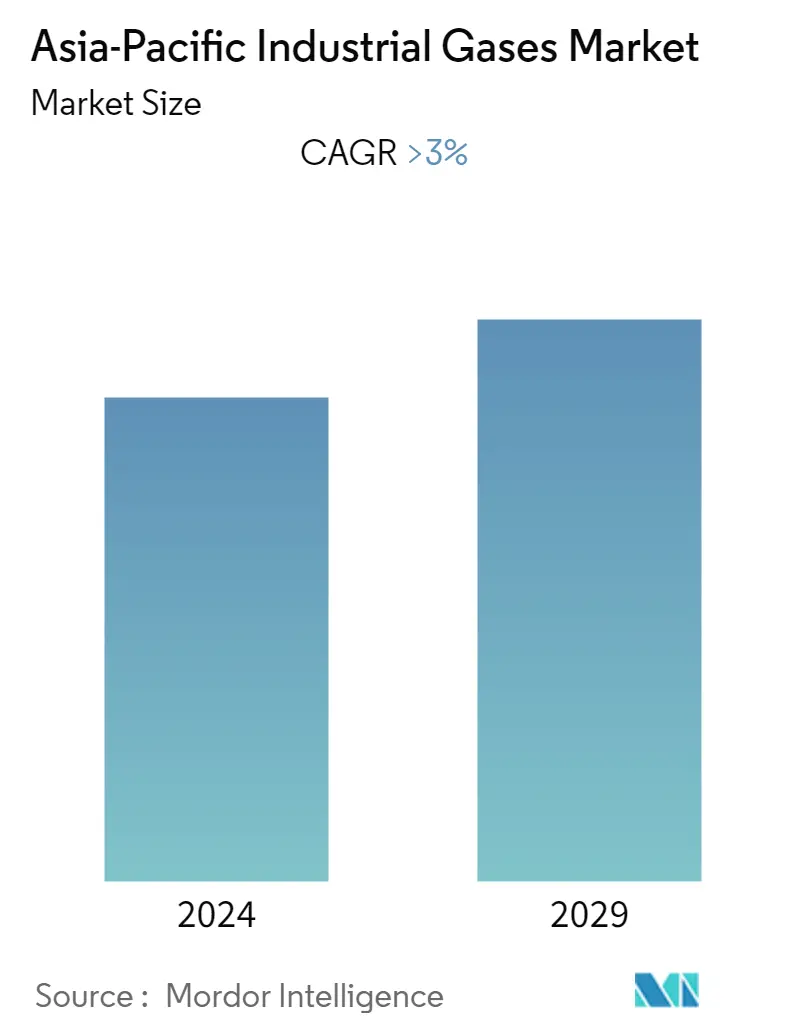
| Study Period | 2019 - 2029 |
| Base Year For Estimation | 2023 |
| Forecast Data Period | 2024 - 2029 |
| Historical Data Period | 2019 - 2022 |
| CAGR | 3.00 % |
| Market Concentration | High |
Major Players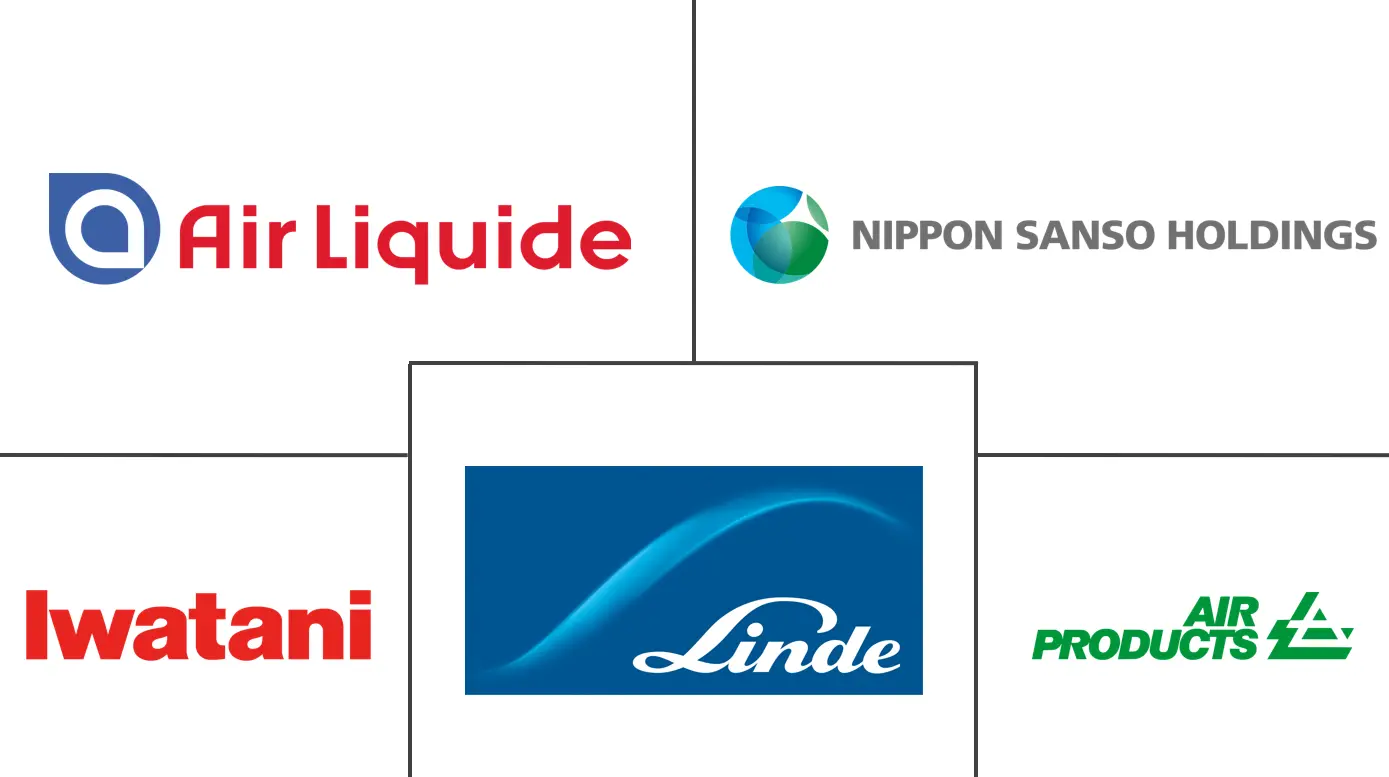
*Disclaimer: Major Players sorted in no particular order |
Need a report that reflects how COVID-19 has impacted this market and its growth?
Asia-Pacific Industrial Gases Market Analysis
The Asia-Pacific industrial gases market is estimated to reach 50.35 million tons by the end of this year. It is projected to reach 60.58 million tons in the next five years, registering a CAGR of 3.77% during the forecast period.
The COVID-19 pandemic affected several industries negatively. The lockdown in most countries in the region caused disruptions in industrial activities and freight transportation that disturbed the supply chain in nearly every end-user industry. However, the conditions started recovering in 2021, restoring the market's growth trajectory.
- Over the short term, growing demand from the frozen and stored food segment and the growing need for alternate energy sources are major factors driving the growth of the market studied.
- However, the environmental regulations and safety issues concerning industrial gases are likely to restrain the growth of the studied market.
- Nevertheless, growing demand for low-carbon gases in the coming years will likely create lucrative growth opportunities for the market in the coming years.
- China represents the largest market for industrial gases in the region and is likely to witness strong growth in demand on the back of increasing oil and gas production and refining and chemical production capacities.
Asia-Pacific Industrial Gases Market Trends
Chemical Processing and Refining to Dominate the Market
- Industrial gases, such as oxygen, nitrogen, carbon dioxide, hydrogen, methane, and propane, are essential molecules required as reaction agents for various process steps in the chemical production chain.
- Industrial gases provide solutions for inerting, reactor cooling, and pH control. Petrochemicals are substances obtained from the refining and processing of petroleum and natural gases. They require inert atmospheres for transportation and storage, which is provided by nitrogen.
- In refineries, oxygen is used to enrich the air feed to catalytic cracking regenerators, increasing the units' capacity. It is used in sulfur recovery units to achieve similar benefits. Oxygen is also used to regenerate catalysts. Thus, industrial gases are of utmost importance for chemical processing and refining.
- Asia-Pacific has grown to be the hub for chemical processing globally. The chemical industry in China, India, and Japan has been growing rapidly. The largest proportion of the global chemicals market is held by Asia by far. Since 2012, it has continuously accounted for more than half of the global chemicals market.
- Chemical production in Asia overall increased by 4.2% in 2022. India saw a significant increase in production (+4.6%).
- China is not only the largest chemical market but also one of the fastest growing. European Chemical Industry Council (CEFIC) predicts that by 2030, China's share of global chemical sales is likely to rise to about 49%, up from 41% in 2022.
- China is a hub for chemical processing, accounting for a major chunk of the chemicals produced globally. The country contributes to more than 35% of global chemical sales. Many major global companies have their chemical plants in China.
- India is already a refining hub with 21 refineries, with expansion planned to attract foreign investment in export-oriented infrastructure such as product pipelines and export terminals. India's crude oil production in 2022 was 29.7 MMT (million metric tonnes). Refining capacity has increased significantly recently due to the expansion of several refinery projects.
- Therefore, the downstream sector is expected to grow during the forecast period. Additionally, India is the fourth largest importer of liquefied natural gas (LNG). India consumed 204.23 MMT of petroleum products and 63.9 BCM of natural gas in 2022, showing growth of 5.1% and 5% compared to 2021.
- The strong growth momentum in Asia's chemical and refining industries is expected to drive the demand for industrial gases in the region.
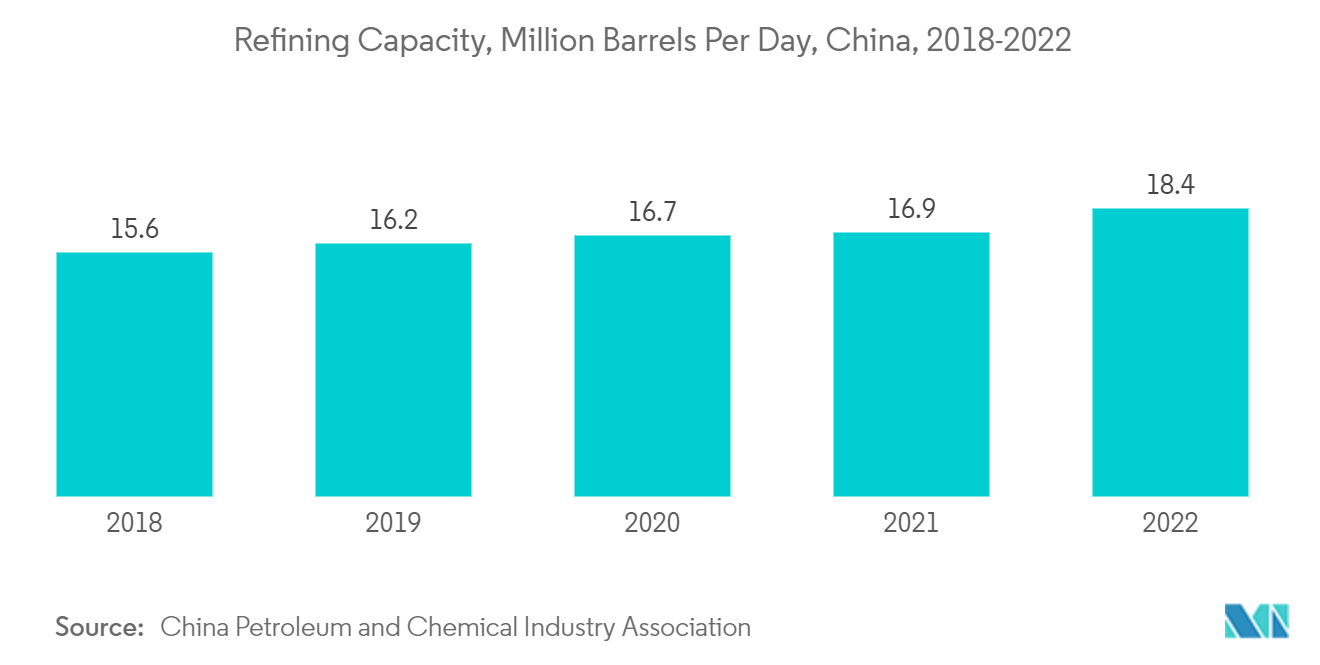
China to Dominate the Regional Market
- China has been one major country in the consumption and production of industrial gases. The country has witnessed various investments in the industrial gas segment.
- In 2023, China unlocked a high-yield industrial gas flow with commercial value in the Cambrian shale, dating back to 540 million years. The global first development holds strategic significance in promoting regional economic and social development and ensuring China's long-term energy security.
- With this latest breakthrough, it is expected that a second shale gas field of trillion-cubic-meter reserves and 10-billion-cubic meter production could be built in China, providing a high-quality clean energy supply to promote Chinese modernization. Considering industrial gas use in this sector, the market can benefit significantly.
- In March 2023, Air Liquide, a major industrial gas player, announced investing around EUR 60 million (USD 65.29 million) to revamp two Air Separation Units (ASUs), which the group operates in the Tianjin industrial basin in China. This announcement comes within the context of the renewal of a long-term industrial gas supply contract with Tianjin Bohua Yongli Chemical Industry Co. Ltd, a subsidiary of Bohua Group.
- As part of this modernization plan, Air Liquide will significantly reduce the carbon dioxide emissions linked to producing oxygen and other gases by adapting these ASUs to run on electrical power instead of steam. Additionally, the group has signed a three-party Memorandum of Understanding with YLC and the Tianjin Binhai District to explore the implementation of Carbon Capture, Use, and Storage (CCUS) solutions.
- Apart from these projects, the demand for industrial gas through various end-user industries is also significant. These gases find applications in multiple industries, such as oil and gas, automotive, metallurgy, and chemical processing.
- In 2022, the Tarim oil and gas production registered a 4% increase over 2021, producing 33.1 MMT (million metric tonnes). According to official plans, the Tarim oil field is expected to produce 40 million tons of oil and gas annually by 2025 and 50 million tons by 2035.
- According to preliminary data from the National Bureau of Statistics of China, power generation in the country increased in 2022, reaching 8,400 TWh (+2.2% compared to 2021). Electricity consumption in 2022 also increased, reaching 8,637 TWh (+3.6% over 2021). Furthermore, in 2022, domestic electricity consumption by urban and rural residents increased by 13.8%.
- China is also the world's biggest automobile market in production and sales. According to OICA (The Organization Internationale des Constructeurs d'Automobiles), vehicle production in China reached a total of 27.02 million units in 2022, which is an increase of 3% over 2021 for the same period.
- In China, the chemical production grew by 5.9% in 2022. The opening up of the Chinese economy is expected to boost domestic demand growth in China, especially in the consumer goods and health and nutrition sectors, and contribute to positive change in the market studied.
- All these end-user industry trends are expected to drive the demand for industrial gases in China.
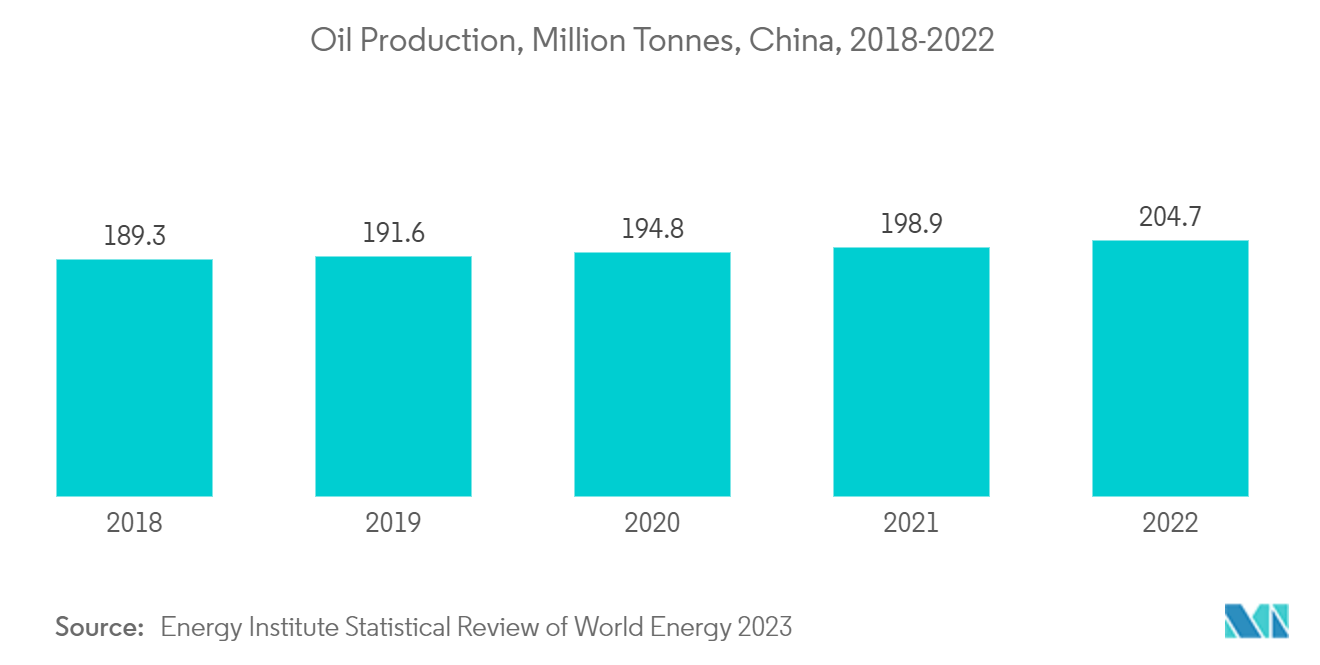
Asia-Pacific Industrial Gases Industry Overview
The Asia-Pacific industrial gases market is consolidated in nature. The major players include (not in any particular order) Linde PLC, Air Liquide, Air Products and Chemicals Inc., Nippon Sanso Corporation, and Iwatani Corporation.
Asia-Pacific Industrial Gases Market Leaders
-
Iwatani Corporation
-
Linde PLC
-
Air Liquide
-
Air Products and Chemicals Inc.
-
Nippon Sanso Corporation
*Disclaimer: Major Players sorted in no particular order
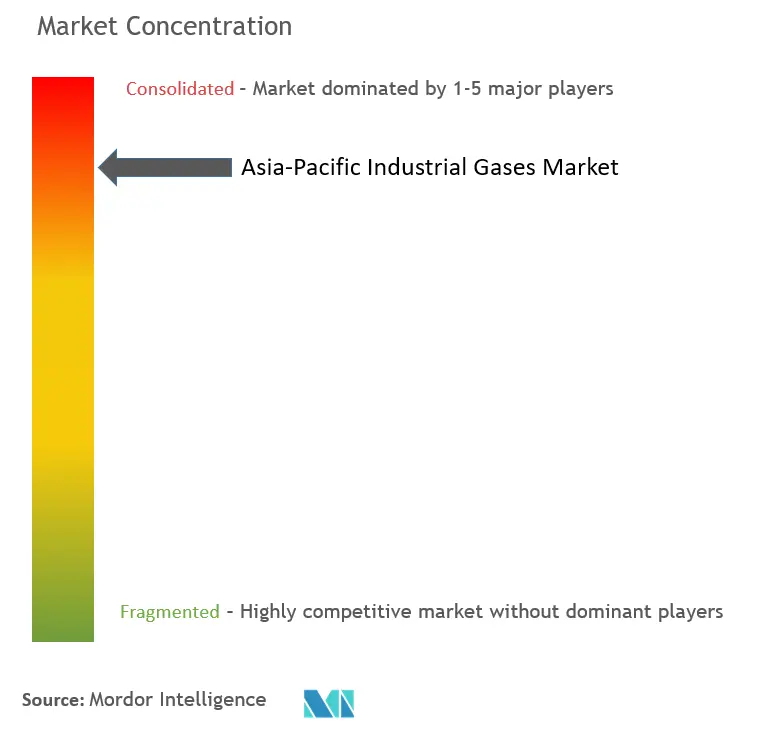
Asia-Pacific Industrial Gases Market News
- December 2022: Yingde Gases announced the completion of the purchase of a 100% share in Shanghai Nanhua Industrial Gas Company Ltd. Yingde Gases' first packaged gas purchase boosted the group's impact in industrial packaged gas and medical oxygen. The purchase is a step forward in the organization's strategic packaged-gas strategy, indicating the group's entry into the market of packaged gas.
- July 2022: Yingde Gases Group announced its collaboration agreement with China Hydrogen, through which the two companies will jointly invest in and establish green hydrogen and green ammonia facilities in Ordos, Inner Mongolia, which will be Yingde Gases' first green ammonia project.
Table of Contents
1. INTRODUCTION
- 1.1 Study Assumptions
- 1.2 Scope of the Study
2. RESEARCH METHODOLOGY
3. EXECUTIVE SUMMARY
4. MARKET DYNAMICS
-
4.1 Drivers
- 4.1.1 Increasing Demand for Frozen and Stored Food
- 4.1.2 Growing Need for Alternate Energy Sources
- 4.1.3 Other Drivers
-
4.2 Restraints
- 4.2.1 Environmental Regulations and Safety Issues
- 4.2.2 Other Restraints
- 4.3 Industry Value Chain Analysis
-
4.4 Industry Attractiveness - Porter's Five Forces Analysis
- 4.4.1 Bargaining Power of Suppliers
- 4.4.2 Bargaining Power of Buyers
- 4.4.3 Threat of New Entrants
- 4.4.4 Threat of Substitute Products and Services
- 4.4.5 Degree of Competition
5. MARKET SEGMENTATION (Market Size in Volume)
-
5.1 By Product Type
- 5.1.1 Nitrogen
- 5.1.2 Oxygen
- 5.1.3 Carbon dioxide
- 5.1.4 Hydrogen
- 5.1.5 Helium
- 5.1.6 Argon
- 5.1.7 Ammonia
- 5.1.8 Methane
- 5.1.9 Propane
- 5.1.10 Butane
- 5.1.11 Other Product Types (Fluorine and Nitrous oxide)
-
5.2 By End-user Industry
- 5.2.1 Chemical Processing and Refining
- 5.2.2 Electronics
- 5.2.3 Food and Beverage
- 5.2.4 Oil and Gas
- 5.2.5 Metal Manufacturing and Fabrication
- 5.2.6 Medical and Pharmaceutical
- 5.2.7 Automotive and Transportation
- 5.2.8 Energy and Power
- 5.2.9 Other End-user Industries (Water Treatment and Environmental Protection)
-
5.3 By Geography
- 5.3.1 China
- 5.3.2 India
- 5.3.3 Japan
- 5.3.4 South Korea
- 5.3.5 ASEAN Countries
- 5.3.6 Rest of Asia-Pacific
6. COMPETITIVE LANDSCAPE
- 6.1 Merger & Acquisitions, Joint Ventures, Collaborations, and Agreements
- 6.2 Market Share (%)**/Ranking Analysis
- 6.3 Strategies Adopted by Leading Players
-
6.4 Company Profiles
- 6.4.1 Air Liquide
- 6.4.2 Air Products and Chemicals Inc.
- 6.4.3 Asia Technical Gas Co. Pte Ltd
- 6.4.4 BASF SE
- 6.4.5 Bhuruka Gases Limited
- 6.4.6 Ellenbarrie industrial Gases
- 6.4.7 Iwatani Corporation
- 6.4.8 Linde PLC
- 6.4.9 Messer SE & Co. KGaA
- 6.4.10 Nippon Sanso Holdings Corporation
- 6.4.11 PT Samator Indo Gas Tbk
- 6.4.12 Yingde Gas
- *List Not Exhaustive
7. MARKET OPPORTUNITIES AND FUTURE TRENDS
- 7.1 Growing Demand for Low-Carbon Gases in the Coming Years
- 7.2 Other Opportunities
Asia-Pacific Industrial Gases Industry Segmentation
Industrial gases are gases produced in relatively large quantities by gas manufacturing companies for use in various industrial manufacturing processes. These gases are sold to other enterprises and industries, including oil and gas, petrochemicals, chemicals, power, mining, steelmaking, metals, environmental protection, medicine, pharmaceuticals, biotechnology, food, water, fertilizers, nuclear power, and electronics.
The Asia-Pacific industrial gases market is segmented by product type, end-user industry, and geography. By product type, the market is segmented into nitrogen, oxygen, carbon dioxide, hydrogen, helium, argon, ammonia, methane, propane, butane, and other types (fluorine and nitrous oxide). By end-user industry, the market is segmented into chemical processing and refining, electronics, food and beverage, oil and gas, metal manufacturing and fabrication, medical and pharmaceutical, automotive and transportation, energy and power, and other end-user industries (water treatment and environmental protection). The report also covers the market size and forecasts for the Asia-Pacific industrial gases market in five countries across the Asia-Pacific region.
For each segment, the market sizing and forecasts are provided on the basis of volume (tons).
| By Product Type | Nitrogen |
| Oxygen | |
| Carbon dioxide | |
| Hydrogen | |
| Helium | |
| Argon | |
| Ammonia | |
| Methane | |
| Propane | |
| Butane | |
| Other Product Types (Fluorine and Nitrous oxide) | |
| By End-user Industry | Chemical Processing and Refining |
| Electronics | |
| Food and Beverage | |
| Oil and Gas | |
| Metal Manufacturing and Fabrication | |
| Medical and Pharmaceutical | |
| Automotive and Transportation | |
| Energy and Power | |
| Other End-user Industries (Water Treatment and Environmental Protection) | |
| By Geography | China |
| India | |
| Japan | |
| South Korea | |
| ASEAN Countries | |
| Rest of Asia-Pacific |
Frequently Asked Questions
What is the current Asia-Pacific Industrial Gases Market size?
The Asia-Pacific Industrial Gases Market is projected to register a CAGR of greater than 3% during the forecast period (2024-2029)
Who are the key players in Asia-Pacific Industrial Gases Market?
Iwatani Corporation, Linde PLC, Air Liquide, Air Products and Chemicals Inc. and Nippon Sanso Corporation are the major companies operating in the Asia-Pacific Industrial Gases Market.
What years does this Asia-Pacific Industrial Gases Market cover?
The report covers the Asia-Pacific Industrial Gases Market historical market size for years: 2019, 2020, 2021, 2022 and 2023. The report also forecasts the Asia-Pacific Industrial Gases Market size for years: 2024, 2025, 2026, 2027, 2028 and 2029.
Asia-Pacific Industrial Gases Industry Report
Statistics for the 2024 Asia-Pacific Industrial Gases market share, size and revenue growth rate, created by Mordor Intelligence™ Industry Reports. Asia-Pacific Industrial Gases analysis includes a market forecast outlook to for 2024 to 2029 and historical overview. Get a sample of this industry analysis as a free report PDF download.

